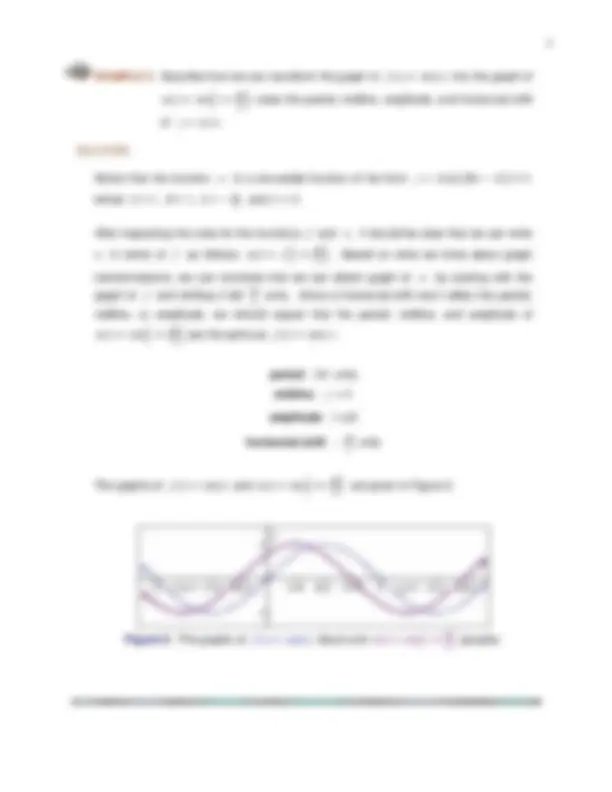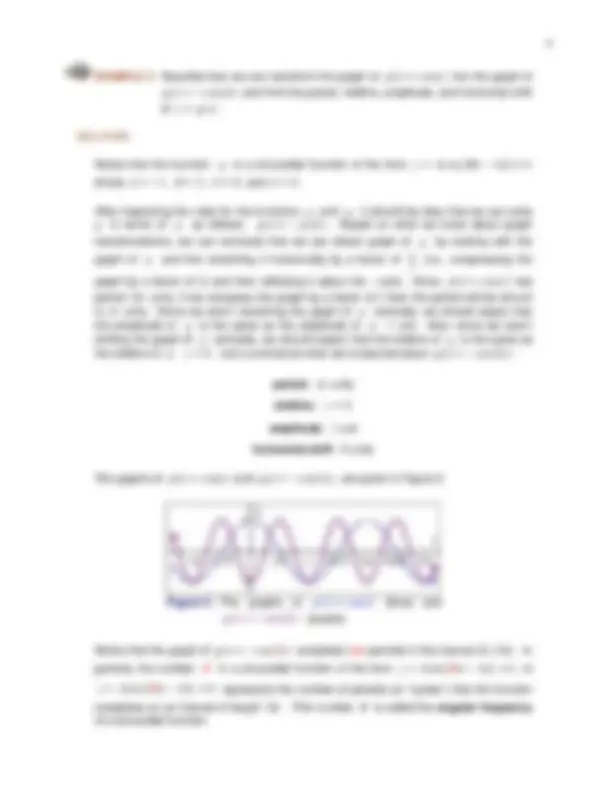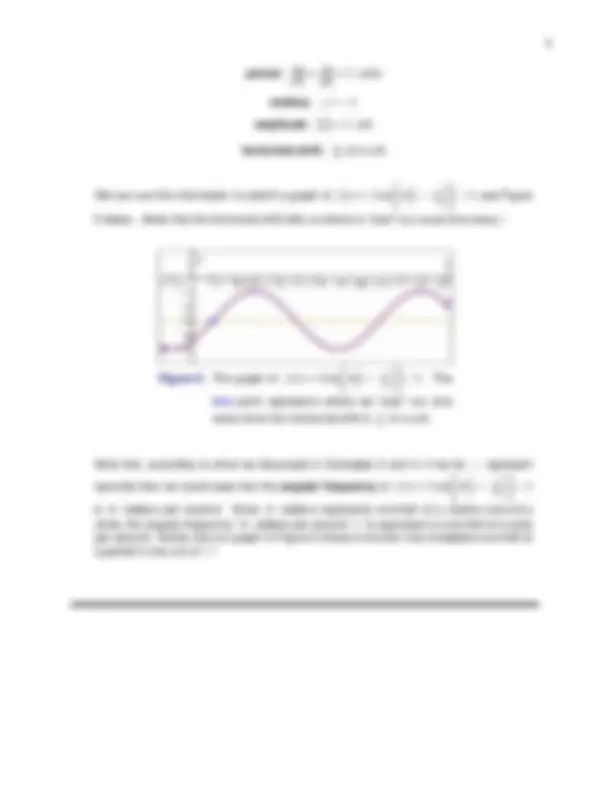






Study with the several resources on Docsity

Earn points by helping other students or get them with a premium plan


Prepare for your exams
Study with the several resources on Docsity

Earn points to download
Earn points by helping other students or get them with a premium plan
Community
Ask the community for help and clear up your study doubts
Discover the best universities in your country according to Docsity users
Free resources
Download our free guides on studying techniques, anxiety management strategies, and thesis advice from Docsity tutors
Material Type: Notes; Class: Elementary Functions; Subject: Math; University: Portland Community College; Term: Unknown 1989;
Typology: Study notes
1 / 8

This page cannot be seen from the preview
Don't miss anything!





Haberman MTH 112
Module 5: Sinusoidal Functions
DEFINITION: A sinusoidal function is function f of the form
NOTE 1: Recall from Module 3 that ( )
2
cos( ) t sin t
π
= + (i.e., since the cosine function is a
transformation of the sine function). Therefore, we can write any function of the form
in the form given in the definition of a sinusoidal function.
Thus, functions of the form
NOTE 2: Based what we know about graph transformations (which are studied in the previous
course), we should recognize that sinusoidal functions are transformations of the
function. Below is a summary of what is studied in the previous course
about graph transformations:
y = sin( ) t
SUMMARY OF GRAPH TRANSFORMATIONS
g t ( ) = A ⋅ f B t ( − h ) + k and
A B h k , , , ∈ R. In order to transform the graph of the function f into the graph of g …
1
st
: horizontally stretch/compress the graph of f by a factor of
1
B
and, if , reflect
it about the y -axis.
2
nd
: shift the graph horizontally h units (shift right if h is positive and left if h is
negative).
3
nd:
vertically stretch/compress the graph by a factor of A and, if A < 0 , reflect it about
the t -axis.
4
th
: shift the graph vertically k units (shift up if k is positive and down if k is
negative).
(The order in which these transformations are performed matters .)
Examples 1 – 4 (below) will provide a review of the graph transformations as well as an
investigation of the affect of the constants A , B , h , and k on the period, midline, amplitude,
and horizontal shift of a sinusoidal function. You may want to follow along by graphing the
functions on your graphing calculator. Don’t forget to change the mode of the calculator to
the radian setting under the heading angle.
EXAMPLE 1: Describe how we can transform the graph of f ( ) t = sin( ) t into the graph of
g t ( ) = 2 sin( ) t − 3. State the period, midline, and amplitude of.
y = g x ( )
SOLUTION :
Our goal is to use Examples 1 – 4 to determine how the constants A , B , h , and k
affect the period, midline, amplitude, and horizontal shift of a sinusoidal function so let’s
start by observing what the values of A , B , h , and k are in. It
should be clear that function g is a sinusoidal function of the form
where
g t ( ) = 2 sin( ) t − 3
y = A sin B t ( − h ) k A = 2 , B = 1 , h = 0 , and k = − 3.
After inspecting the rules for the functions f and g , we should notice that we could
construct the function g t ( ) = 2 sin( ) t − 3 by multiplying the outputs of the function
f ( ) t = sin( ) t by 2 and then subtracting 3 from the result. We can express this
algebraically with the equation below:
g t ( ) = 2 f ( ) t − 3
Based on what we know about graph transformations, we can conclude that we can
obtain graph of g by starting with the graph of f and first stretching it vertically by a
factor of 2 and then shifting it down 3 units. Since f ( ) t = sin( ) t has amplitude 1 unit, if
we stretch it vertically by a factor of 2 then we’ll double the amplitude, so we should
expect that the amplitude of g to be 2 units. Also, since f ( ) t = sin( ) t has midline
, when we shift it down 3 units to draw the graph of g , the resulting midline will be
. (Note that since graphing g required no horizontal transformations of
y = 0
y = − 3
f ( ) t = sin( ) t , the graph of g must have the same period as the graph of f ( ) t = sin( ) t :
2 π units.) Let’s summarize what we’ve learned about g t ( ) = 2 sin( ) t − 3 :
period : 2 π units
midline : y = − 3
amplitude : 2 units
horizontal shift : 0 units
The graphs of f ( ) t = sin( ) t and g t ( ) = 2 sin( ) t − 3 are given in Figure 1 below.
Figure 1: The graphs of f ( ) t = sin( ) t and g t ( ) = 2 sin( ) t − 3.
EXAMPLE 3: Describe how we can transform the graph of p t ( ) = cos( ) t into the graph of
and find the period, midline, amplitude, and horizontal shift
of.
q t ( ) = −cos(2 ) t
y = q x ( )
SOLUTION :
Notice that the function q is a sinusoidal function of the form
y = A cos B t ( − h ) + k
where A = − 1 , B = 2 , h = 0 , and k = 0.
After inspecting the rules for the functions p and q , it should be clear that we can write
q in terms of p as follows: q t ( ) = − p (2 ) t. Based on what we know about graph
transformations, we can conclude that we can obtain graph of q by starting with the
graph of p and first stretching it horizontally by a factor of
1
2
(i.e., compressing the
graph by a factor of 2 ) and then reflecting it about the t -axis. Since has
period
p t ( ) =cos( ) t
2 π units, if we compress the graph by a factor of 2 then the period will be shrunk
the amplitude of q is the same as the amplitude of p : 1 unit. Also, since we aren’t
shifting the graph of p vertically, we should expect that the midline of q is the same as
the midline of p : y = 0. Let’s summarize what we’ve learned about q t ( ) = −cos(2 ) t :
midline : y = 0
amplitude : 1 unit
horizontal shift : 0 units
The graphs of p t ( ) = cos( ) t and q t ( ) = − cos(2 ) t are given in Figure 3.
Figure 3: The graphs of p t ( ) = cos( ) t (blue) and
q t ( ) = −cos(2 ) t (purple).
Notice that the graph of q t ( ) = − cos( 2 t ) completes two periods in the interval [0, 2 π ]. In
general, the number B in a sinusoidal function of the form
y = A sin B ( t − h ) + k
or
represents the number of periods (or “cycles”) that the function
completes on an interval of length 2
y = A cos B ( t − h ) k
π. This number B is called the angular frequency
of a sinusoidal function.
When we use sinusoidal functions to represent real-life situations, we often take the input
variable to be a unit of time. Suppose that in the function q t ( ) = − cos(2 ) t , t represents
seconds. Since the input of the cosine function must be radians, the units of must
be “radians per second”. This way,
radians
second
⋅ t seconds = 2 t radians,
which has the appropriate units for the input of the cosine function. So if t represents
seconds, the angular frequency of q t ( ) = − cos(2 ) t is “ 2 radians per second”.
Another way to obtain the unit of the angular frequency is to use what we noticed above:
the number 2 in represents the number of cycles that the function
completes on an interval of length 2
q t ( ) = − cos( 2 t )
π. Since a cycle is equivalent to a complete rotation
around a circle, or 2 π radians, two cycles is equivalent to 4 π radians. If the input
variable t represents seconds, then the angular frequency is
4
2
radians
seconds
rad/sec
π
π
EXAMPLE 4: Describe how we can transform the graph of p t ( ) = cos( ) t into the graph
( ) ( )
1
2 3
w t ( ) 3 p t 5
π
= − +. State the period, midline, amplitude, and
horizontal shift of y = w x ( ).
SOLUTION :
Notice that the function w is a sinusoidal function of the form
y = A cos B t ( − h ) + k
where A = 3 ,
1
2
3
h
π
= , and k = 5.
After inspecting the rules for the functions p and w , it should be clear that we can write
w in terms of p as follows: ( ) ( )
1
2 3
w t ( ) 3 p t 5
π
= − +. Based on what we know about
graph transformations, we can conclude that we can obtain graph of q by starting with
the graph of p and first stretching it horizontally by a factor of 2 , then shifting it right
3
π
units, then stretching it vertically by a factor 3 , and finally shifting it up 5 units. Since
p t ( ) = cos( ) t has period 2 π units, if we stretch the graph by a factor of 2 then the period
will be stretched to 4 π units. Similarly, if we stretch the graph of vertically
by a factor of 3 then we’ll triple the amplitude, so we should expect the amplitude of w to
be 3 units. Also, since has midline
p t ( ) =cos( ) t
p t ( ) = cos( ) t y = 0 , when we shift it up 5 units to
draw the graph of w , the resulting midline will be y = 5. Since we are shifting the graph
Based on what we learned in the examples above, we can summarize the affect of the
constants A , B , h , and k on the period, midline, amplitude, and horizontal shift of functions
of the form and
y = A sin B t ( − h ) k
y = A cos B t ( − h ) + k.
SUMMARY: Graphs of Sinusoidal Functions
The graphs of the sinusoidal functions
y = A sin B t ( − h ) + k and
y = A cos B t ( − h ) + k
(where A B h k , , , ∈ R ) have the following properties:
period:
2
B
π
units
midline: y = k
amplitude: A units
horizontal shift: h units
angular frequency: B radians per unit of t
EXAMPLE 5: Sketch a graph of
4
f t ( ) 2sin t 3
π
SOLUTION :
In order to use what we’ve just studied about functions of the form
, we need to write the given function in this form, i.e., we need to
factor
y = A sin B t ( − h ) + k
4
t
π
π − ”:
4
1
4
( ) 2sin 3
2sin 3
f t t
t
π
It should be clear that
1
4
is a sinusoidal function of the form
where
1
4
h = , and k = − 3. Using what we
found above, we can find the period, midline, amplitude, and horizontal shift of y = f t ( ):
period :
2 2
2
B
π π
π
= = units
midline : y = − 3
amplitude : 2 = 2 unit
horizontal shift:
1
4
of a unit
We can use this information to sketch a graph of
1
4
; see Figure
5 below. (Note that the horizontal shift tells us where to “start” our usual sine wave.)
Figure 5: The graph of
1
4
. The
blue point represents where we “start” our sine
wave since the horizontal shift is
1
4
of a unit.
Note that, according to what we discussed in Examples 3 and 4, if we let t represent
seconds then we could state that the angular frequency of
1
4
per second. Notice that our graph in Figure 5 shows a function that completes one-half of
a period in one unit of t!